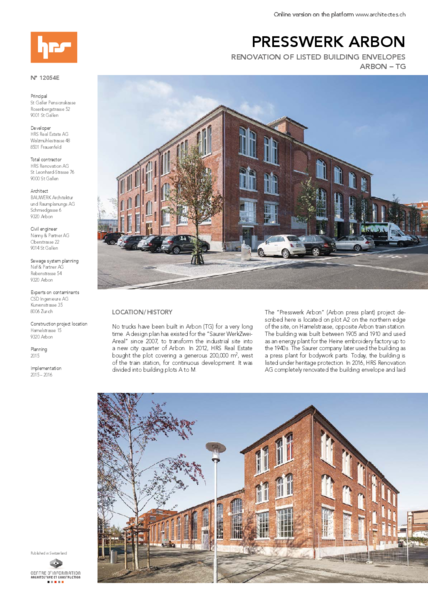Presswerk Arbon - E
Culture - Sports - Loisirs
Culture - Sports - Loisirs
LOCATION / HISTORY
No trucks have been built in Arbon (TG) for a very long time. A design plan has existed for the “Saurer WerkZwei-Areal” since 2007, to transform the industrial site into a new city quarter of Arbon. In 2012, HRS Real Estate bought the plot covering a generous 200,000 m2, west of the train station, for continuous development. It was divided into building plots A to M.
The “Presswerk Arbon” (Arbon press plant) project described here is located on plot A2 on the northern edge of the site, on Hamelstrasse, opposite Arbon train station. The building was built between 1905 and 1910 and used as an energy plant for the Heine embroidery factory up to the 1940s. The Saurer company later used the building as a press plant for bodywork parts. Today, the building is listed under heritage protection. In 2016, HRS Renovation AG completely renovated the building envelope and laid the foundations for the new “Presswerk Arbon” culture and arts centre.
In the south hall, the Saurer vintage vehicles club has set up an exhibition area for vintage vehicles and textile machines. The north hall is used by the Kulturzentrum Presswerk AG cultural centre for events: up to 700 visitors come here to enjoy art, music, dance, theatre and exhibitions. The head-end building has housed the Arbon music school since summer 2017.
LISTED BUILDING
The former press plant is built of reinforced concrete using the Hennebique technique. The French engineer François Hennebique (1842 - 1921) is one of the pioneers of reinforced concrete: his construction system was used throughout Europe in numerous buildings. Because there are only two buildings in Arbon using Hennebique’s construction technique, the former press plant is of great interest in terms of architectural and construction history.
The press plant is also important from the point of view of economic history. It is the only building to have been used over a long period by both Heine and Saurer, Arbon’s two global corporations. Therefore, parts of the building – apart from the former vehicle repair shop that used to be on the western side of the press plant – are listed.
RENOVATION PLAN
The halls of the former press plant were stripped down to the load-bearing structure and then the roof and the façade underwent historically accurate renovation and restoration. The exposed brickwork of the eastern façade had to be cleaned several times by lye treatment.
The steel windows of the south hall as well as the windowsills and casings were also thoroughly renovated, and all windowpanes were replaced. In accordance with listed building requirements, new wood windows were also manufactured and installed in the north hall and the head-end building. Part of the project was also to dismantle the former automobile workshop that used to be on the west side of the renovated building. The current users were responsible for thefinal configuration of the press plant.
SPECIAL FEATURES
Because the building is listed as a historic building, a restoration concept had to be submitted to the preservation of historic monuments department. The greatest challenge proved to be the historically faithful reproduction of the filigree, up to 5-meter-tall, wood windows with their extremely slim profiles. The current requirements for soundproofing had to be considered and the windows also had to be fitted with insulating glass. In agreement with the preservation of historic monuments department,it was finally decided to produce the five meter-tall windows in three parts to meet all requirements.
The renovation of the steel windows was also carried out in accordance with listed building requirements. The effective but gentle system of dry ice blasting with solid carbon dioxide (CO2) was used to clean the window frames. Dry ice has a temperature of -110.02 degrees Fahrenheit and hits the material to be cleaned at high speed, with minimal damage to the underlying surface. After the dry blasting, the CO2 evaporates completely into the air and leaves no residue. After cleaning, the steel window frames were repainted.
To match the original appearance, new glass was manufactured using the Fourcault process, typical of the period, in which an endless, flat, glass ribbon is pulled vertically from the molten glass.
ENERGY CONCEPT / SUSTAINABILITY
While the exhibition hall for the Saurer vintage vehicles club can manage without heating, the Arbon music school and the event hall are connected to the Morgental energy park district heating. The energy park, operated by Elektra Birseck Münchenstein (EBM), produces district heat mostly from sewage gasses from the ARA Morgental wastewaters as well as from scrap wood.
 Accès membres
Accès membres

 Page précédente
Page précédente





